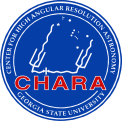Science at the CHARA Array
CHARA research is focused on studying the astrophysical properties of stars at high angular resolution using long-baseline optical/infrared interferometry. The Center operates the CHARA Array, a six-telescope optical/infrared interferometric array on Mount Wilson, California. The CHARA Array provides the highest resolution of any telescope at visible and near-infrared wavelengths making it among the most powerful facilities in the world for studying stars and stellar systems at resolutions not previously available. Among the Array's "firsts" are:
* First direct detection of gravity darkening on a single star (Regulus)
* First direct measurement of the "P-factor" in the Baade-Wesselink method (δ Cep)
* First detection of hot exozodiacal dust around a main-sequence star (Vega)
* First model-independent measurement of an exoplanet diameter (HD 189733b)
* First angular diameter for a halo population star (μ Cas)
* First image of a single, main-sequence star (Altair)
* First direct image of an interacting binary (β Lyr)
* Shortest-period (1.14 days) binary star system yet resolved (σ2 CrB)
* First image of a binary star system in eclipse (ε Aur)
* Earliest images of a nova explosion (V339 Del)
* First direct images of starspots on a magnetically active star (ζ And, λ And)
Additional Resources
Follow links below to see refereed publications based on CHARA results, technical reports, and review articles on interferometry:
See Science Highlights for an overview of the science topics being investigated at the CHARA Array.



